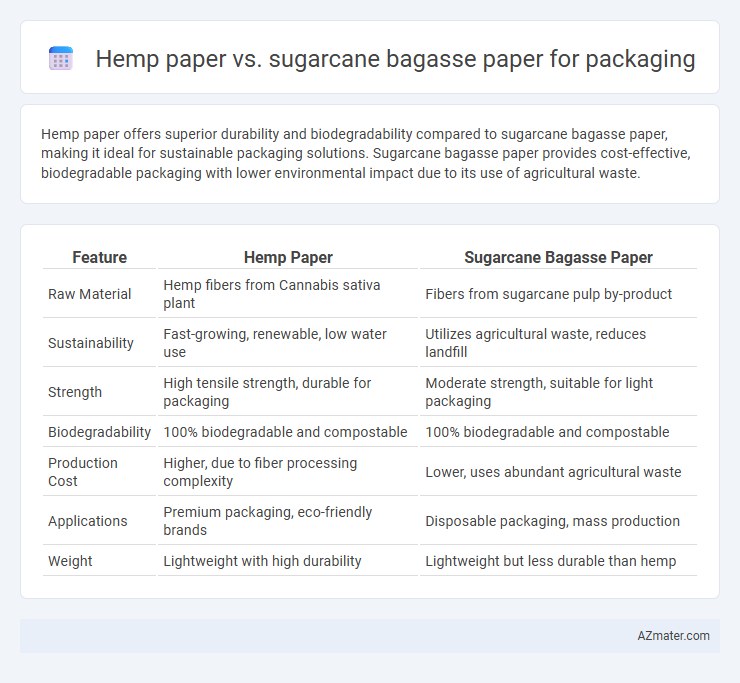Hemp paper offers superior durability and biodegradability compared to sugarcane bagasse paper, making it ideal for sustainable packaging solutions. Sugarcane bagasse paper provides cost-effective, biodegradable packaging with lower environmental impact due to its use of agricultural waste.
Table of Comparison
| Feature | Hemp Paper | Sugarcane Bagasse Paper |
|---|---|---|
| Raw Material | Hemp fibers from Cannabis sativa plant | Fibers from sugarcane pulp by-product |
| Sustainability | Fast-growing, renewable, low water use | Utilizes agricultural waste, reduces landfill |
| Strength | High tensile strength, durable for packaging | Moderate strength, suitable for light packaging |
| Biodegradability | 100% biodegradable and compostable | 100% biodegradable and compostable |
| Production Cost | Higher, due to fiber processing complexity | Lower, uses abundant agricultural waste |
| Applications | Premium packaging, eco-friendly brands | Disposable packaging, mass production |
| Weight | Lightweight with high durability | Lightweight but less durable than hemp |
Introduction: The Rise of Sustainable Packaging Materials
Hemp paper and sugarcane bagasse paper have emerged as leading sustainable packaging materials due to their renewable origins and eco-friendly manufacturing processes. Hemp paper is prized for its durability, natural resistance to degradation, and high cellulose content, which contributes to superior strength compared to traditional wood pulp paper. Sugarcane bagasse paper, derived from the fibrous residue of sugarcane after juice extraction, offers a biodegradable and carbon-neutral alternative that reduces agricultural waste and supports circular economy principles in packaging industries.
Overview of Hemp Paper and Sugarcane Bagasse Paper
Hemp paper, derived from the fibrous stalks of the Cannabis sativa plant, offers high durability, biodegradability, and resistance to tearing, making it suitable for sustainable packaging solutions. Sugarcane bagasse paper, produced from the fibrous residue left after extracting juice from sugarcane, is a renewable material known for its cost-effectiveness, smooth texture, and ability to be composted easily. Both materials reduce dependence on traditional wood pulp, promoting eco-friendly packaging with lower environmental impact.
Raw Material Sources and Availability
Hemp paper is derived from the fibrous stalks of the hemp plant, known for its rapid growth and high cellulose content, making it a sustainable raw material with year-round availability in suitable climates. Sugarcane bagasse paper is produced from the fibrous residue left after sugar extraction, utilizing agricultural waste that is abundantly available in sugar-producing regions, thus reducing reliance on wood pulp. The widespread cultivation of sugarcane ensures a consistent supply of bagasse, while hemp's cultivation is limited by regional regulations and climate, influencing raw material accessibility for packaging applications.
Environmental Impact: Cultivation and Harvesting
Hemp paper production has a lower environmental impact due to hemp's rapid growth and minimal need for pesticides or herbicides, making it a sustainable crop with efficient land use. Sugarcane bagasse paper utilizes the fibrous byproduct of sugar extraction, reducing agricultural waste but often depends on intensive monoculture practices that can degrade soil health and biodiversity. The cultivation of hemp sequesters more CO2 per acre compared to sugarcane, contributing to better carbon capture during the harvesting phase.
Manufacturing Process Comparison
Hemp paper manufacturing involves harvesting stalks, retting to separate fibers, and mechanically processing them into pulp, yielding strong, long fibers ideal for durable packaging. Sugarcane bagasse paper production uses the fibrous residue left after juice extraction, which undergoes washing, pulping, and bleaching, producing a more cost-effective and sustainable paper variant with shorter fibers. The hemp process demands more water and energy but results in higher tensile strength, while bagasse paper supports waste valorization with relatively lower environmental impact in large-scale packaging applications.
Physical Properties: Strength, Texture, and Durability
Hemp paper exhibits superior tensile strength and durability compared to sugarcane bagasse paper, making it ideal for packaging requiring high resistance to tearing and wear. The texture of hemp paper is typically smoother and more consistent, providing a premium feel and improved printability over the coarser, fibrous surface of sugarcane bagasse paper. While sugarcane bagasse paper offers good stiffness, its lower strength and quicker degradation under moisture limit its usability for heavy-duty or long-term packaging applications.
Biodegradability and Compostability
Hemp paper exhibits superior biodegradability and compostability due to its natural fiber composition and lower chemical processing requirements, enabling it to break down faster in composting environments. Sugarcane bagasse paper, derived from agricultural waste, also offers excellent biodegradability but may contain residual agrochemicals that slightly affect its composting rate. Both materials present environmentally friendly alternatives to conventional packaging, with hemp paper often outperforming sugarcane bagasse paper in rapid decomposition and soil nutrient contribution.
Cost Analysis and Market Accessibility
Hemp paper generally has higher production costs due to labor-intensive cultivation and processing, but it offers superior durability and sustainability, which can justify a premium price in niche markets. Sugarcane bagasse paper benefits from abundant agricultural waste supply, resulting in lower raw material costs and wider market accessibility, particularly in regions with established sugar industries. While hemp paper appeals to eco-conscious consumers seeking premium packaging, sugarcane bagasse paper's cost-effectiveness and scalability make it more suitable for mass-market packaging solutions.
Packaging Performance and Applications
Hemp paper exhibits superior durability, tear resistance, and moisture control compared to sugarcane bagasse paper, making it ideal for heavy-duty packaging and long-term storage. Sugarcane bagasse paper offers eco-friendly, biodegradable packaging solutions with moderate strength, best suited for lightweight products and short-term use. Both materials enhance sustainability in packaging, but hemp's higher fiber tensile strength supports more demanding applications such as industrial wrapping and protective packaging.
Future Trends and Industry Outlook
Hemp paper offers superior durability and sustainability due to its fast-growing nature and high cellulose content, making it a promising material for eco-friendly packaging solutions. Sugarcane bagasse paper, derived from agricultural waste, aligns with circular economy principles by reducing landfill waste and serving as a cost-effective alternative for mass-market packaging. The packaging industry is expected to increasingly adopt these bio-based materials driven by regulatory pressures, consumer demand for sustainability, and innovations in processing technologies enhancing the performance and scalability of hemp and bagasse paper products.

Infographic: Hemp paper vs Sugarcane bagasse paper for Packaging
 azmater.com
azmater.com